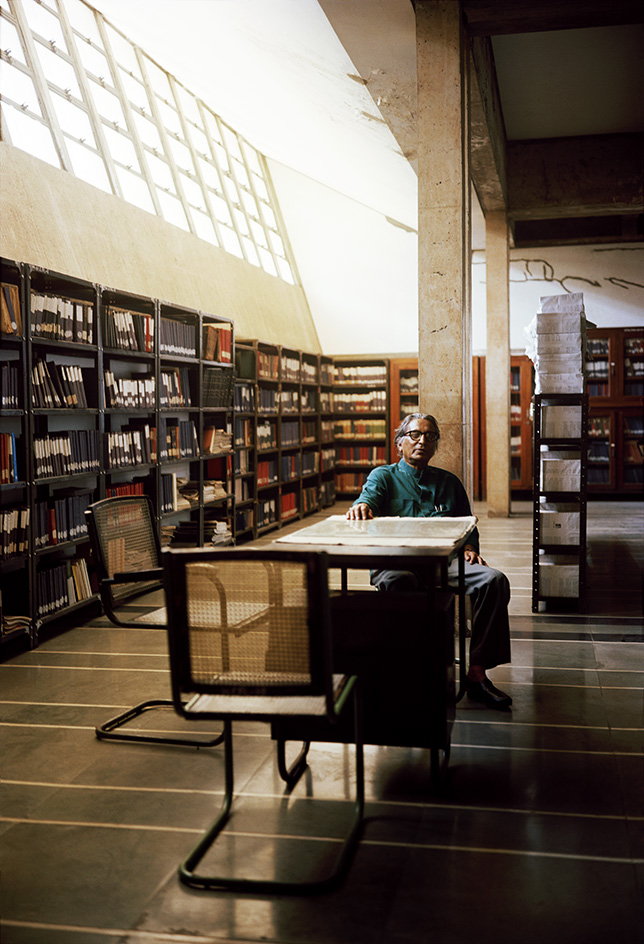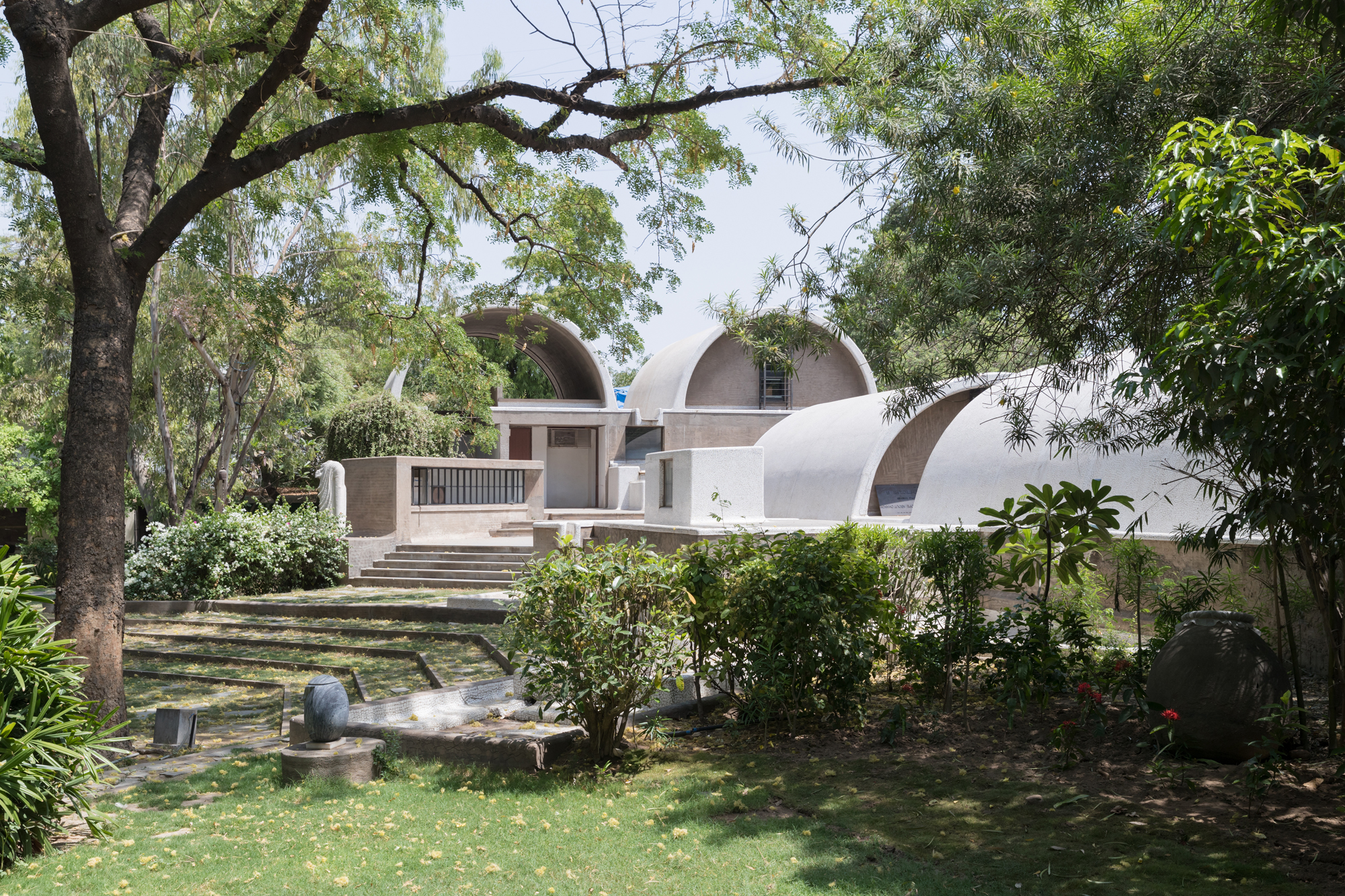In memoriam: Balkrishna V Doshi (1927 – 2023)
Balkrishna V Doshi, one of India’s preeminent architects and the world’s greatest modernists, has died at the age of 95. To honour his memory, we revisit a story from the Wallpaper* archives

A glance at the dates and it's clear that Balkrishna V Doshi and modern Indian architecture grew side by side. A student at the JJ School of Art in Mumbai when India celebrated its independence in 1947, the architect's career runs alongside the creation of some of the country's most iconic contemporary architecture. From his involvement in the Chandigarh project and India's famous Le Corbusier and Louis Kahn heritage, through to its finest architecture education institution – he designed and founded the School of Architecture and Planning in Ahmedabad in 1962 – Dr Balkrishna Vithaldas Doshi has been an omnipresent figure for a remarkable period of India's built environment.

The architect inside the Institute of Indology library in 2011. Doshi built it in 1962 to house thousands of rare Indian books, manuscripts and art
In the words of Balkrishna V Doshi (1927 – 2023)
Having personally had a hand in forming what many people see as modern Indian architecture, Doshi's views about how the country's architecture has shaped and will shape its identity carry weight. His position is very much about the bigger picture. ‘Social identity is Indian identity; we are gregarious people,’ he says. ‘Porosity, change and transformation form the Indian identity. And there is no single aesthetic, as stylistic identity is not a real identity. India is not about a production line, it is not about doing things in a certain way.’

Doshi is adamant about addressing the architectural concerns of contemporary India – from the country's painful inequalities to its infrastructure and sustainability issues. It is all about linking great work, especially on an urban level, to India's wider context. 'How can we place our work on a larger canvas? I think this is our problem; the profession is not addressing issues on a larger scale,' he says. 'This doesn't mean we need to eliminate the individual, but architectural work must make some references to the concerns of the people.'

His practice Vastu-Shilpa, which he founded in 1956 (a research institute and foundation of the same name followed in 1962), certainly reflects this. Set up as a partnership firm, where each partner also has their own projects under the Vastu-Shilpa umbrella, the firm has a dynamic research and urban planning leg that works towards translating cultural and climatic characteristics into appropriate architectural forms from the smaller to the larger scale.
Born in Pune in 1927, Doshi is now well into his eighties, but shows no signs of slowing down. 'I still go to the office every day,' he says, when, that is, he isn't travelling the world attending lectures and conferences. Internationally respected by his peers, Doshi has made his mark as a prolific thinker and teacher, perfecting the application of Le Corbusier's modernist teachings - absorbed during a long stint at the master's Indian office in the 1950s – within the Indian context.

Tagore Memorial Hall
His sense of community in relation to architecture is equally strong. 'I began my career talking about low-cost housing and housing for the poor. This is how one has to work, at the lowest level. Because there is a lot more to learn there. The poor are the ones who are ingenious, frugal, simple, their socioeconomic ties are fantastic,' says Doshi. 'And this is the role of architecture; to be a catalyst for change.'
So where does Indian architecture stand today in relation to the rest of the world? There is no doubt that there is plenty of potential in the country. 'There are opportunities for work here both for the iconic, as well as the barefoot architect,' says Doshi. 'The question is how do these really work in the context of the quality that India stands for.'
Receive our daily digest of inspiration, escapism and design stories from around the world direct to your inbox.

The entrance lobby at Tagore Memorial Hall
Globalisation is a further opportunity that India should be well placed to handle, he explains, having itself been born from a melange of cultures, people and traditions over centuries. 'In the past, people were working towards absorbing and finding solutions that were appropriate to the place. That concept should be even more relevant now.'
Perhaps, unsurprisingly, it all comes down to the eternal dilemma of sustainability at all levels. 'It really is the fundamental question that needs to be asked when looking for any local identity. All cultures have talked about this,' says Doshi. 'Our culture is like blotting paper; you don't know which layer has happened when. I think that culture is our strength. Despite diverse languages, diverse climates, diverse traditions, we thrive on our interaction with one another.'
A version of this article was first published in the June 2011 issue of Wallpaper*
Ellie Stathaki is the Architecture & Environment Director at Wallpaper*. She trained as an architect at the Aristotle University of Thessaloniki in Greece and studied architectural history at the Bartlett in London. Now an established journalist, she has been a member of the Wallpaper* team since 2006, visiting buildings across the globe and interviewing leading architects such as Tadao Ando and Rem Koolhaas. Ellie has also taken part in judging panels, moderated events, curated shows and contributed in books, such as The Contemporary House (Thames & Hudson, 2018), Glenn Sestig Architecture Diary (2020) and House London (2022).
-
 Click to buy: how will we buy watches in 2026?
Click to buy: how will we buy watches in 2026?Time was when a watch was bought only in a shop - the trying on was all part of the 'white glove' sales experience. But can the watch industry really put off the digital world any longer?
-
 Don't miss these art exhibitions to see in January
Don't miss these art exhibitions to see in JanuaryStart the year with an inspiring dose of culture - here are the best things to see in January
-
 Unmissable fashion exhibitions to add to your calendar in 2026
Unmissable fashion exhibitions to add to your calendar in 2026From a trip back to the 1990s at Tate Britain to retrospectives on Schiaparelli, Madame Grès and Vivienne Westwood, 2026 looks set to continue the renaissance of the fashion exhibition
-
 A day in Ahmedabad – tour the Indian city’s captivating architecture
A day in Ahmedabad – tour the Indian city’s captivating architectureIndia’s Ahmedabad has a thriving architecture scene and a rich legacy; architect, writer and photographer Nipun Prabhakar shares his tips for the perfect tour
-
 Inside a creative couple's magical, circular Indian home, 'like a fruit'
Inside a creative couple's magical, circular Indian home, 'like a fruit'We paid a visit to architect Sandeep Virmani and social activist Sushma Iyengar at their circular home in Bhuj, India; architect, writer and photographer Nipun Prabhakar tells the story
-
 The Architecture Edit: Wallpaper’s houses of the month
The Architecture Edit: Wallpaper’s houses of the monthFrom wineries-turned-music studios to fire-resistant holiday homes, these are the properties that have most impressed the Wallpaper* editors this month
-
 This modernist home, designed by a disciple of Le Corbusier, is on the market
This modernist home, designed by a disciple of Le Corbusier, is on the marketAndré Wogenscky was a long-time collaborator and chief assistant of Le Corbusier; he built this home, a case study for post-war modernism, in 1957
-
 A refined Indian country residence reimagines the farmhouse
A refined Indian country residence reimagines the farmhouseSet among Karnataka’s rolling fields and forest, House by the Grove by Taliesyn Design & Architecture combines modern materials with an open approach to the elements
-
 Half bridge, half home: Wallmakers’ latest project takes architecture to daring new heights
Half bridge, half home: Wallmakers’ latest project takes architecture to daring new heightsHovering above a forest stream in Maharashtra, Bridge House pushes the limits of engineering and eco-conscious design
-
 Louis Kahn, the modernist architect and the man behind the myth
Louis Kahn, the modernist architect and the man behind the mythWe chart the life and work of Louis Kahn, one of the 20th century’s most prominent modernists and a revered professional; yet his personal life meant he was also an architectural enigma
-
 The Architecture Edit: Wallpaper’s houses of the month
The Architecture Edit: Wallpaper’s houses of the monthFrom Malibu beach pads to cosy cabins blanketed in snow, Wallpaper* has featured some incredible homes this month. We profile our favourites below